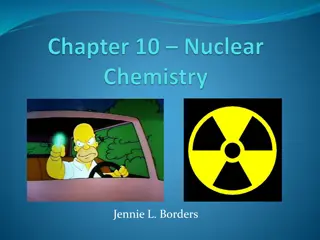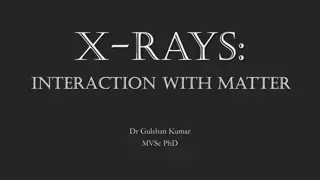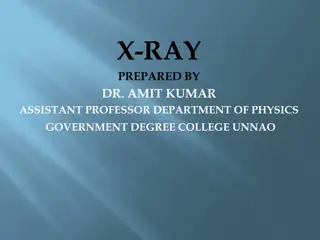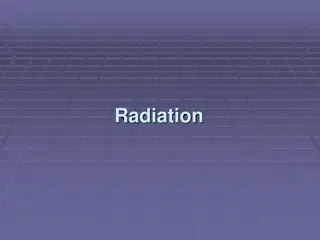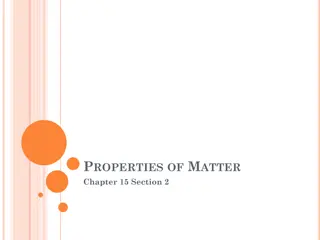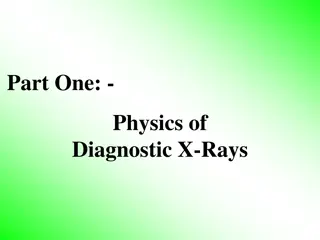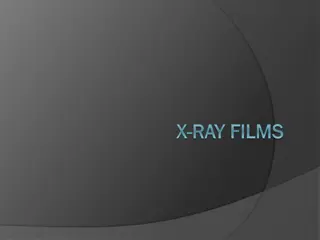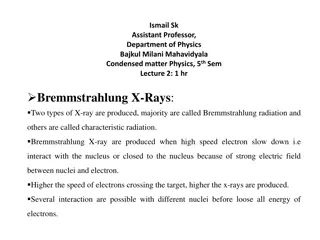X-Rays: Properties, Production, and Regulations
X-rays are a form of high-energy electromagnetic radiation that can penetrate most objects. Learn about the properties of X-rays, their production through atomic processes in heavy metals like tungsten, and the regulations governing their use in medical physics. Understand the potential dangers of X-ray exposure and how electrons interact to produce X-ray photons. Explore topics such as Bremsstrahlung radiation and characteristic X-rays in this informative lecture series.
Download Presentation

Please find below an Image/Link to download the presentation.
The content on the website is provided AS IS for your information and personal use only. It may not be sold, licensed, or shared on other websites without obtaining consent from the author.If you encounter any issues during the download, it is possible that the publisher has removed the file from their server.
You are allowed to download the files provided on this website for personal or commercial use, subject to the condition that they are used lawfully. All files are the property of their respective owners.
The content on the website is provided AS IS for your information and personal use only. It may not be sold, licensed, or shared on other websites without obtaining consent from the author.
E N D
Presentation Transcript
AL Department of Medical Physics The fourth Stage AL- -Mustaqbal Department of Medical Physics The fourth Stage Mustaqbal University College University College Radiation Protection LECTURE EIGHT : LECTURE EIGHT : X Rays X Rays & & X X- -Ray Regulations Ray Regulations Aaat. prof . Dr Forat Hamzah Dr. AmeenAlwan
LECTURE EIGHT X Rays , X-Ray Regulations , Basic Nuclear Physics X-Ray Properties of X-Ray Production of X-Ray X-Ray Regulations 2
LECTURE EIGHT : X Rays X-rays are a form of electromagnetic radiation that has a higher energy and can pass through most objects, including the body Properties of X-Ray X-ray is a type of electromagnetic radiation with frequency of 1018Hz and wavelength of 10-10m (high frequency and very short wavelength). . X-ray has the ability to pass through liquids, solids, gases and many materials. . X-ray is traveling in a straight line. . X-ray is invisible to the eye. . Long x-ray exposure can be harmful to living organisms, and short exposure to x-rays is not harmful. . X-rays can be a very dangerous type of radiation because they have a high frequency and high energy. . When x-rays hit the material, electrons of this material will be ejected from the atom leaving behind a positive charge. For this reason, x-ray radiation is sometimes known as ionizing radiation.
LECTURE EIGHT : X Rays Production of X-Ray Beams There are various atomic processes that can produce X-ray photons, and they all occur in the heavy atoms of tungsten. One : Bremsstrahlung "braking radiation." Two : Characteristic X-ray. They can both occur in the heavy atoms of tungsten. X-rays are photons of electromagnetic radiation produced when a target of heavy metal (Tungsten is often the material chosen for the target or anode of the x-ray tube) is struck by electrons traveling at high speed. It is difficult to accelerate the electrons in air, so the process has to be curried in vacuum. Only about 1 % of the electrons produce an X-ray photon; the rest is lost in heating up the target. 1 .
LECTURE EIGHT : X Rays One : Bremsstrahlung "braking radiation." Braking radiation is produced when a high-speed electron interacts with a nucleus, as follows : ) ( Diagram showing the generation process of X- ray (braking radiation) When the electron passes close to the nucleus, it will be deviated from its original path due to Coulomb forces (Maxwell's theory) . So, according to Maxwell's general theory of electromagnetic rays, the energy increase through a vacuum by the electromagnetic field. As the electron approaches the nucleus, it will be affected by the electromagnetic field emanating from the nucleus, and it will suffer a sudden negative acceleration and deviation as a result of this. Thus, the deviation of the electron from its path causes lose its energy in the form of Bremsstrahlung x-ray.
LECTURE EIGHT : X Rays Two : Characteristic X-ray. : Characteristic X-rays are produced when an electron incident on the atom, as follows : ) ( K L M . The incident electron (which carries a kinetic energy) on the atom causes the electron to move out of the K, L, or M orbitals, leaving the atom ionized. Diagram showing the generation process of X-ray (Characteristic X-ray) . This electron will carry an energy that is its binding energy in its orbit from which it exited. . After the short lifetime of the excited electrons, they return to the lower energy state or ) ( ground state (spontaneous) by releasing energy in the form of photons. ) ( This photons (releasing energy) represents characteristic X-ray.
LECTURE EIGHT : X Rays X-Ray Regulations The regulations on the handling of X rays are very similar to the regulations on standard radiation protection. The X-ray regulations in the European Union apply to those X-ray tubes and X-ray installations in which electrons are accelerated at least to 5 keV and in which they are limited to a maximum energy of 1 MeV. All installations in which electrons can be accelerated to energies beyond 1MeV are subject to the regulations of standard radiation protection. Devices and installations that produce unwanted radiation, like old-fashioned TV screens, where electrons are accelerated up to energies of something like 20 keV, do not require a license if a dose rate of 1 Sv/h at a distance of 10 cm from the surface is not exceeded or if they are approved by the competent authority by way of a design approval.
LECTURE EIGHT : X Rays The X-ray regulations, of course, mainly concern X-ray tubes used for X-ray diagnosis and X-ray therapy on humans. It is desirable to obtain the best X-ray image available for a particular radiation exposure. At the same time one should try to reduce the radiation exposure by improving the X-ray detection system and image reconstruction without affecting the image quality. The radiation dose of the patient has to be documented. If the patient wants a copy for patients of the documentation about the received X-ray doses, it has to be provided to the patient 8







